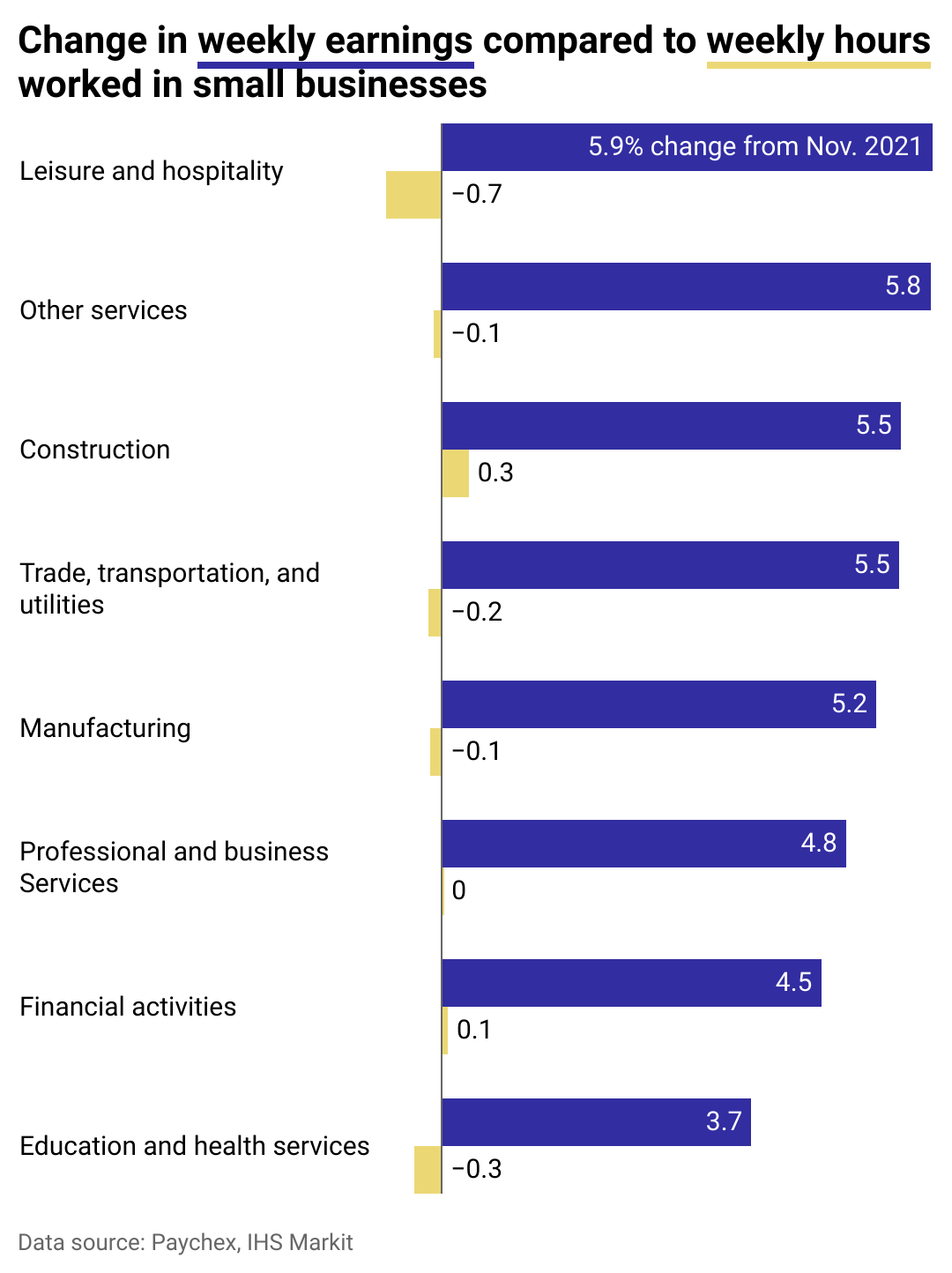How America’s small businesses are handling pay raises in a competitive job market
Cameron Prins // Shutterstock
How America’s small businesses are handling pay raises in a competitive job market
Manager and waitress laughing atdigital tablet
Although a tight labor market might benefit job seekers, it’s squeezing employers—including small businesses.
Despite recent headlines that U.S. worker productivity has dropped sharply in 2022 and tech, media, and e-commerce giants are shedding workers in widescale layoffs, the overall job market remains robust. If everyone looking for work got a job today, there would still be millions of jobs available, according to the latest data from the Bureau of Labor Statistics and the Chamber of Commerce. The result is an economy where workers still appear to have the upper hand: ready to quit their jobs and look for new ones at any moment, knowing opportunities far outnumber candidates.
More than 6 million American small businesses in 2021 had at least one employee, according to the Small Business Administration. Since 1995, 62% of new jobs have come from small businesses. The way small businesses treat their employees is more important than ever, as any decline in worker satisfaction could lead to another letter of resignation. Naturally, pay is among the top priorities for job seekers—whether they want to keep up with inflationary rises or simply see an opportunity to leverage for a pay bump—so the size of raises businesses give their employees is critical.
Swyft Filings compiled data from the National Federation of Independent Business, Paychex, and IHS Markit to determine how small businesses handle pay raises in this labor market. NFIB data came from surveys of small business owners, while the data from Paychex and IHS Markit comes from aggregated payroll information from clients of Paychex.
Keep reading to discover how small businesses are adjusting their payroll strategies to fit the current labor market.
![]()

Swyft Filings
Earnings climb despite dip in hours worked
Line chart showing that weekly earnings for small business employees have grown despite fewer hours reported.
Small-business workers saw their hours cut by 60% in March 2020 because of COVID-19-related shutdowns, according to a study by Yale economists.
After that dip, employees at small businesses saw their hourly wages—along with the number of hours they worked—climb. But work hours began trending downward by late 2020 and continued their decline through 2021. Earnings and work hours rose again in 2022, with weekly earnings for small business employees reaching an average of $31 per hour, according to Paychex/IHS Markit. Weekly earnings increased the most for small business employees in the South, who saw an average 5.12% year-over-year growth, or about $47.83 more a week. Employees in the Northeast saw their average weekly wages rise slowest in the past year at 4.18%, or about $41.27, more a week.
The U.S. unemployment rate has hovered at 4.2% or lower since November 2021, and the ongoing tight labor market has put the pressure on employers to increase wages to keep and recruit workers. A 2022 survey conducted by Gallup found that 64% of employees named pay and benefits as critical factors in finding a new job.

Swyft Filings
When it comes to wages, not all industries pay the same
Bar chart showing leisure and hospitality has been the industry with the greatest increase in earnings.
After travel spending reached an all-time pandemic high in September 2022, it remained 3% above 2019 pre-pandemic levels through the fall, according to the U.S. Travel Association. With travel bouncing back and more people attending in-person events, dining at restaurants, and staying at hotels, small business employees in the leisure and hospitality industry saw weekly earnings rise to nearly 6% of year-over-year growth. Small businesses in the leisure and hospitality industry—among those hit hardest by pandemic restrictions—are now struggling to meet surging demand to fill roles. This imbalance of available labor and job openings helped propel the industry to take the lead for weekly earning growth.
Following the travel and leisure industry, jobs in repair and maintenance, laundry services, and membership associations—all roles grouped under “other services” by the BLS—also saw an increase in wages with a slight decrease in hours.Construction has maintained year-over-year growth of more than 5% for six months, a strong indicator that workers are also in high demand. While education and health services have been increasing wages since 2011, their growth lags compared to other industries.
Rawpixel.com // Shutterstock
Fewer small businesses expect to increase compensation now than last year
Man and woman behind a bakery counter
Unfortunately for employees, the outlook on potential pay raises isn’t very encouraging.
According to NFIB data, the share of employers who said they expected to increase compensation between October 2022 and December 2022 is at December 2019 levels and trending downward. Furthermore, the most recent survey conducted by the NFIB reinforced that impression. Nearly 59% of small business owners said they expect to keep employee compensation the same from November 2022 to January 2023. Considering 64% of these respondents also said that they expect their volume of sales to stay flat or drop a little during the same period, it may explain why many are hesitant to increase wages—only about 20% of small business owners believe sales will increase, according to the survey.
This story originally appeared on Swyft Filings and was produced and
distributed in partnership with Stacker Studio.







